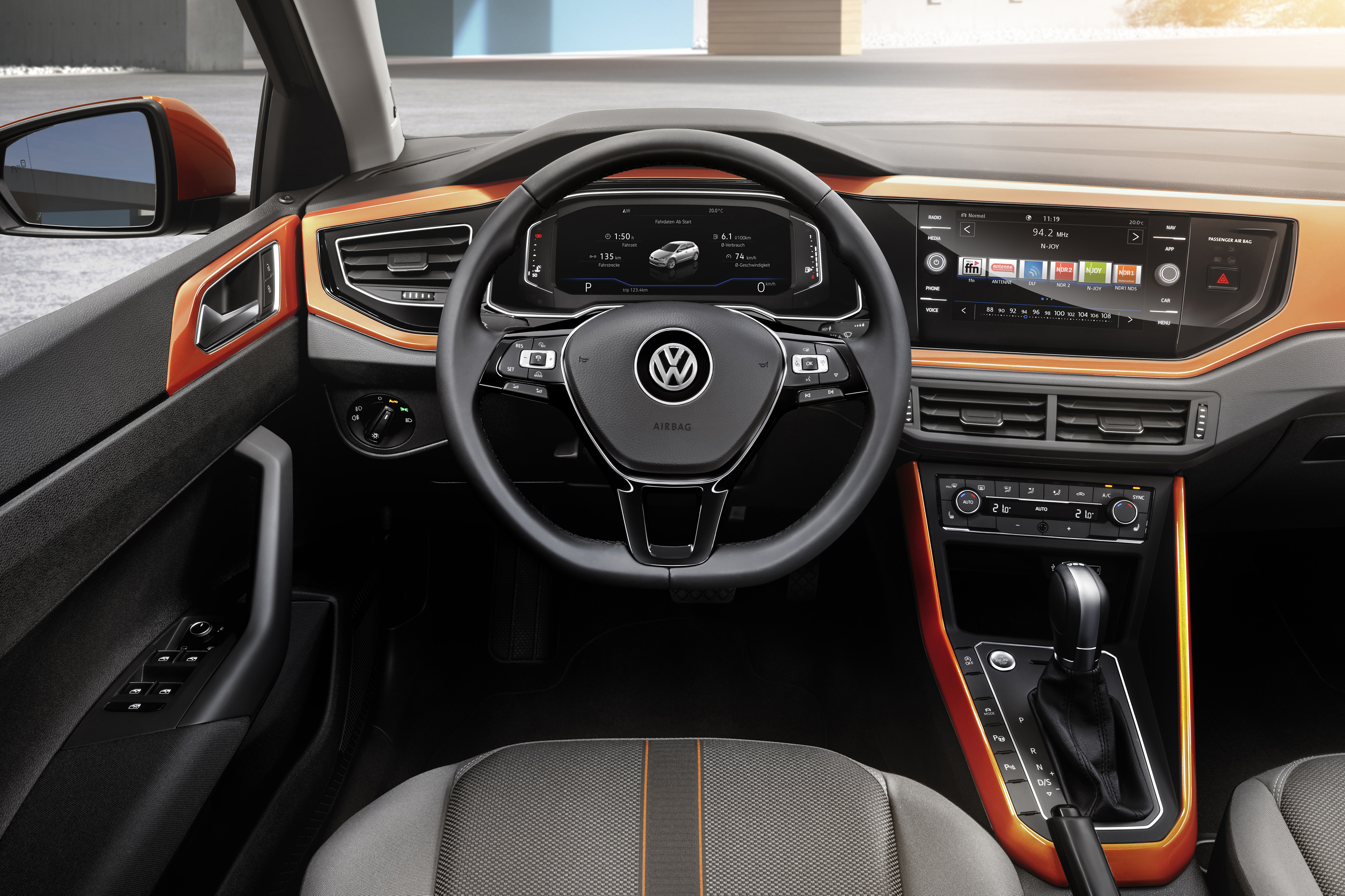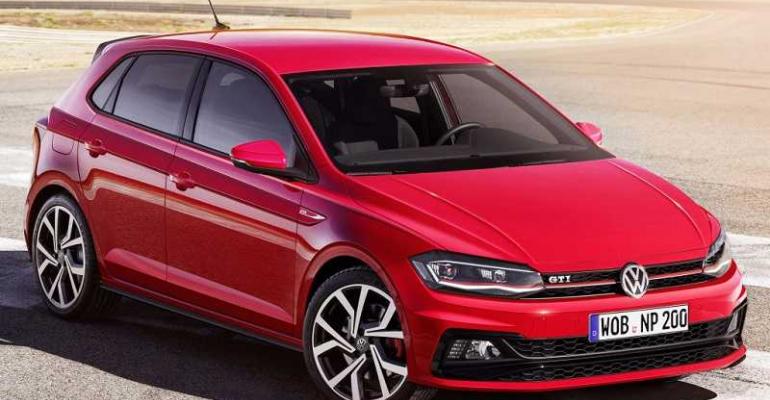WOLFSBURG, Germany – Volkswagen Chairman Herbert Diess unveils the sixth-generation Polo at the company’s headquarters here, revealing an outwardly larger, significantly roomier and more technically sophisticated model than today’s 8-year-old car.
Set for European deliveries in November following a planned public debut at the upcoming Frankfurt auto show, the ʼ17-model-year Polo will be produced in 5-door hatchback form, with buyers offered a choice of up to six engines. The most powerful of the group, the range-topping 2.0L turbocharged 4-cyl. GTi model set for right-hand-drive production in early 2018, equals the Ford Fiesta ST’s 197 hp.
The new Polo has been developed from the ground up in an engineering program that also encompasses the mechanically identical fifth-generation SEAT Ibiza and yet-to-be-launched fourth-generation Skoda Fabia, as well as upcoming production versions of the Volkswagen T-Breeze and SEAT Arona.
Key among the compact-car competition for the new model are the Ford Fiesta, Vauxhall Corsa, Renault Clio and Nissan Micra.
Based on the German automaker’s MQB AO platform architecture, the new Volkswagen has grown significantly to match the dimensional gains made by many of its more contemporary compact-class rivals. Its wheelbase is 3.7 ins. (94 mm) longer than the fifth-generation Polo at 101.0 ins. (2,565 mm), while the track widths are up by 2.4 ins. (61 mm) at the front to 60.3 ins. (1,532 mm) and by 1.9 ins. (48 mm) at the rear to 59.3 ins. (1,506 mm) to provide it with a considerably larger footprint than ever before.
The previous Polo was based on Volkswagen’s PQ25 platform, whose engineering dates back to the fourth-generation model launched in 2001.
The adoption of the new underpinnings, which employ a combination of hot-formed steel and aluminum within the floorpan for added weight savings and support a McPherson-strut front and torsion-beam rear suspension, provide a more progressive exterior design, VW brand-design boss Klaus Bischoff says.
“Better proportions create the framework for a more confident appearance,” he says. “We have capitalized on the realignment of dimensions with an expressive design. It’s a car that fits perfectly with our times both visually and technologically.”
Despite being immediately recognizable as a Volkswagen, Bischoff and his team of designers have incorporated a number of new elements on the new car, including a distinctive swage-line graphic that provides additional structure to the bodywork in an area above the door handles.
At 159.6 ins. (4,054 mm) long, 68.9 ins. (1,750 mm) wide and 59.9 ins. (1,521 mm) high, it is 3.2 ins. (81 mm) longer, 2.5 ins. (64 mm) wider and 0.3 in. (8 mm) lower than its predecessor.
The new Polo will be sold in six different trim lines. Included are the familiar Trendline, Comfortline and Highline trims, a special Beats edition with an upgraded sound system and an R-line featuring re-profiled bumpers, standard 16-in. alloy wheels and darkened exterior elements. 
At the top of the line-up is the GTi. It receives a number of traditional design touches, including uniquely styled bumpers, a honeycomb grille insert, red highlights within the headlamps, 17-in. alloy wheels, a rear spoiler atop the rear hatchback, LED taillamps and dual chromed tailpipes.
The decision to dispense with the 3-door bodystyle, which traditionally has accounted for over 30% of worldwide Polo sales, comes on the back of slowing demand and follows similar moves with the latest Renault Clio, Nissan Micra and SEAT Ibiza – all of which are offered exclusively in 5-door form.
The increase in external dimensions combines with the improved packaging offered by the new MQB AO platform to provide the new Polo with a larger interior boasting a claimed 0.6 in. (15 mm) increase in headroom up front and 1.2 in. (30 mm) increase in headroom in the rear. VW also quotes a 2.5-cu.-ft. (71 L) improvement in cargo capacity at 12.4 cu.-ft. (31.5 L).
As with the exterior, the interior has been thoroughly redesigned, with a newly styled dashboard featuring new steering wheel and more contemporary switchgear at the center of the changes. Analog instruments remain standard, though buyers can option the new Polo with the latest version of Volkswagen’s Active Info Display digital instruments along with a wide number of connectivity functions, including a wireless smartphone charging pad and keyless access.
Drawing on technology already introduced on the larger Golf, the new Polo also comes as standard with VW’s front-assist, city-emergency-braking and pedestrian-monitoring systems as well as a tire-pressure-monitoring function and a speed limiter.
Volkswagen confirms the Polo will be sold with the choice of four gasoline and a sole diesel engine in varying states of tune, although not all will be available at the time of launch. Each receives a standard stop/start function and brake energy recuperation for improved efficiency.
Gearboxes include either a standard 5- or 6-speed manual, with a 7-speed dual-clutch unit available as an option in combination with the more powerful engines on offer. Despite developing the smaller version of the MQB platform to accept all-wheel drive, Volkswagen says all new 6th-generation Polo models will be sold exclusively with front-wheel drive.
Among the gasoline engines is a 1.0L 3-cyl. multipoint-injected unit with either 64 hp or 74 hp in a pair of price-leading 1.0 MPI models. It is joined from the outset by a more sophisticated turbocharged 1.0L 3-cyl. direct injection engine offering either 94 hp or 113 hp in two new 1.0 TSI models.
Further up is a new 1.5 TSI run by Volkswagen’s newly developed turbocharged 1.5L 4-cyl. direct injection gasoline engine with 148 hp.
Topping the lineup is the new GTI. It eschews the turbocharged 1.8L 4-cyl. direct injection engine of its predecessor for a larger 2.0L 4-cyl. turbocharged, direct injection powerplant offering an added 8 hp at 197 hp.
Reflecting a waning demand for diesel engines in the class in which it competes, Volkswagen will launch the new Polo with just one diesel. The carryover turbocharged 1.6L 4-cyl. common-rail unit delivers either 80 hp or 95 hp in a pair of 1.6 TDI models – both of which receive a SCR (selective catalytic reduction) converter as standard.
Also available in selected markets will be a natural-gas-propelled 1.0 TGI model running a specially adapted version of Volkswagen’s turbocharged 1.0L 4-cyl. direct-injection gasoline engine developing 89 hp.
First introduced in 1975, the Polo has tallied some 14 million sales to date.





